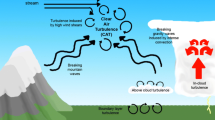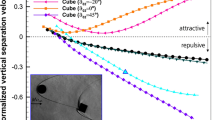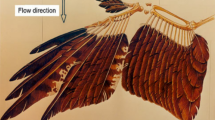Abstract
This paper investigates the formation and evolution of the unsteady three-dimensional wake structures generated by the flapping wings of the DelFly II micro aerial vehicle in forward flight configuration. Time-resolved stereoscopic particle image velocimetry (Stereo-PIV) measurements were carried out at several spanwise-aligned planes in the wake, so as to allow a reconstruction of the temporal development of the wake of the flapping wings throughout the complete flapping cycle. Simultaneous thrust-force measurements were performed to explore the relation between the wake formation and the aerodynamic force generation mechanisms. The three-dimensional wake configuration was subsequently reconstructed from the planar PIV measurements by two different approaches: (1) a spatiotemporal wake reconstruction obtained by convecting the time-resolved, three-component velocity field data of a single measurement plane with the free-stream velocity; (2) for selected phases in the flapping cycle a direct three-dimensional spatial wake reconstruction is interpolated from the data of the different measurement planes, using a Kriging regression technique. Comparing the results derived from both methods in terms of the behavior of the wake formations, their phase and orientation indicate that the spatiotemporal reconstruction method allows to characterize the general three-dimensional structure of the wake, but that the spatial reconstruction method can reveal more details due to higher streamwise resolution. Comparison of the wake reconstructions for different values of the reduced frequency allows assessing the impact of the flapping frequency on the formation and interaction characteristics of the vortical structures. For low values of the reduced frequency, it is observed that the vortex structure formation of instroke and outstroke is relatively independent of each other, but that increasing interaction occurs at higher reduced frequencies. It is further shown that there is a phase lag in the appearance of the structures for increasing flapping frequency, which is in correlation with the generation of the forces. Comparison of thrust generated during the instroke and the outstroke phases of the flapping motion in conjunction with the development of the wake structures indicates that wing–wing interaction at the start of outstroke (peel motion) becomes a dominant feature for reduced frequencies greater than 0.62.













Similar content being viewed by others
Notes
The reader is referred to ‘www.delfly.nl’ for more detailed information about the DelFly.
References
Birch JM, Dickinson MH (2001) Spanwise flow and the attachment of the leading-edge vortex on insect wings. Nature 412:729–733. doi:10.1038/35089071
Birch JM, Dickson WB, Dickinson MH (2004) Force production and flow structure of the leading edge vortex on flapping wings at high and low Reynolds numbers. J Exp Biol 207:1063–1072. doi:10.1242/jeb.00848
Bomphrey RJ, Lawson NJ, Harding NJ et al (2005) The aerodynamics of Manduca sexta: digital particle image velocimetry analysis of the leading-edge vortex. J Exp Biol 208:1079–1094. doi:10.1242/jeb.01471
Bomphrey RJ, Lawson NJ, Taylor GK, Thomas ALR (2006) Application of digital particle image velocimetry to insect aerodynamics: measurement of the leading-edge vortex and near wake of a Hawkmoth. Exp Fluids 40:546–554. doi:10.1007/s00348-005-0094-5
Bomphrey RJ, Taylor GK, Thomas ALR (2009) Smoke visualization of free-flying bumblebees indicates independent leading-edge vortices on each wing pair. Exp Fluids 46:811–821. doi:10.1007/s00348-009-0631-8
Bomphrey RJ, Henningsson P, Michaelis D, Hollis D (2012) Tomographic particle image velocimetry of desert locust wakes: instantaneous volumes combine to reveal hidden vortex elements and rapid wake deformation. J R Soc Interface 9:3378–3386. doi:10.1098/rsif.2012.0418
Bruggeman B (2010) Improving flight performance of DelFly II in hover by improving wing design and driving mechanism. MSc thesis, Delft University of Technology
de Baar JHS, Percin M, Dwight RP et al (2014) Kriging regression of PIV data using a local error estimate. Exp Fluids 55:1650. doi:10.1007/s00348-013-1650-z
de Clercq KME, de Kat R, Remes B et al (2009) Aerodynamic experiments on DelFly II: unsteady lift enhancement. Int J Micro Air Veh 1:255–262
de Croon GCHE, Groen MA, De Wagter C et al (2012) Design, aerodynamics and autonomy of the DelFly. Bioinspir Biomim 7:025003. doi:10.1088/1748-3182/7/2/025003
Ellington CP (1984) The aerodynamics of hovering insect flight. IV. Aeorodynamic mechanisms. Philos Trans R Soc Lond Ser B Biol Sci 305:79–113. doi:10.1098/rstb.1984.0052
Ellington CP, van den Berg C, Willmott AP, Thomas ALR (1996) Leading-edge vortices in insect flight. Nature 384:626–630
Ford CWP, Babinsky H (2013) Lift and the leading-edge vortex. J Fluid Mech 720:280–313. doi:10.1017/jfm.2013.28
Ghosh SK, Dora CL, Das D (2012) Unsteady wake characteristics of a flapping wing through 3D TR-PIV. J Aerosp Eng 25:547–558. doi:10.1061/(ASCE)AS.1943-5525.0000185
Groen M (2010) PIV and force measurements on the flapping-wing MAV DelFly II. MSc thesis, Delft University of Technology
Groen M, Bruggeman B, Remes B et al (2010) Improving flight performance of the flapping wing MAV DelFly II. Int Micro Air Vehicle Conf Flight Compet, Braunschweig Germany
Hedenström A, Rosén M, Spedding GR (2006) Vortex wakes generated by robins Erithacus rubecula during free flight in a wind tunnel. J R Soc Interface 3:263–276. doi:10.1098/rsif.2005.0091
Hedenström A, Johansson LC, Wolf M et al (2007) Bat flight generates complex aerodynamic tracks. Science 316:894–897. doi:10.1126/science.1142281
Jeong J, Hussain F (1995) On the identification of a vortex. J Fluid Mech 285:69–94. doi:10.1017/S0022112095000462
Lehmann F-O (2001) The efficiency of aerodynamic force production in Drosophila. Comp Biochem Physiol A 131:77–88
Lehmann F-O (2004) The mechanisms of lift enhancement in insect flight. Naturwissenschaften 91:101–122. doi:10.1007/s00114-004-0502-3
Lehmann F-O, Sane SP, Dickinson MH (2005) The aerodynamic effects of wing–wing interaction in flapping insect wings. J Exp Biol 208:3075–3092. doi:10.1242/jeb.01744
Marden JH (1987) Maximum lift production during takeoff in flying animals. J Exp Biol 130:235–238
Mazaheri K, Ebrahimi A (2011) Experimental investigation on aerodynamic performance of a flapping wing vehicle in forward flight. J Fluids Struct 27:586–595. doi:10.1016/j.jfluidstructs.2011.04.001
Miller LA, Peskin CS (2009) Flexible clap and fling in tiny insect flight. J Exp Biol 212:3076–3090. doi:10.1242/jeb.028662
Muijres FT, Johansson LC, Barfield R et al (2008) Leading-edge vortex improves lift in slow-flying bats. Science 319:1250–1253. doi:10.1126/science.1153019
Muijres FT, Spedding GR, Winter Y, Hedenström A (2011) Actuator disk model and span efficiency of flapping flight in bats based on time-resolved PIV measurements. Exp Fluids 51:511–525. doi:10.1007/s00348-011-1067-5
Muijres FT, Johansson LC, Bowlin MS et al (2012) Comparing aerodynamic efficiency in birds and bats suggests better flight performance in birds. PLoS One. doi:10.1371/journal.pone.0037335
Nakata T, Liu H, Tanaka Y et al (2011) Aerodynamics of a bio-inspired flexible flapping-wing micro air vehicle. Bioinspir Biomim 6:045002. doi:10.1088/1748-3182/6/4/045002
Percin M, Hu Y, van Oudheusden BW, Scarano F (2011) Wing flexibility effects in clap-and-fling. Int J Micro Air Veh 3:217–227
Ren H, Wu Y, Huang PG (2013) Visualization and characterization of near-wake flow fields of a flapping-wing micro air vehicle using PIV. J Vis 16:75–83. doi:10.1007/s12650-012-0152-z
Sane SP (2003) The aerodynamics of insect flight. J Exp Biol 206:4191–4208. doi:10.1242/jeb.00663
Scarano F (2013) Tomographic PIV: principles and practice. Meas Sci Technol 24:012001. doi:10.1088/0957-0233/24/1/012001
Shyy W, Aono H, Chimakurthi SK et al (2010) Recent progress in flapping wing aerodynamics and aeroelasticity. Prog Aerosp Sci 46:284–327. doi:10.1016/j.paerosci.2010.01.001
Spedding GR, Rosén M, Hedenström A (2003) A family of vortex wakes generated by a thrush nightingale in free flight in a wind tunnel over its entire natural range of flight speeds. J Exp Biol 206:2313–2344. doi:10.1242/jeb.00423
Srygley RB, Thomas ALR (2002) Unconventional lift-generating mechanisms in free-flying butterflies. Nature 420:660–664. doi:10.1038/nature01223
Weis-Fogh T (1973) Quick estimates of flight fitness in hovering animals, including novel mechanisms for lift production. J Exp Biol 59:169–230
Zhao L, Deng X, Sane SP (2011) Modulation of leading edge vorticity and aerodynamic forces in flexible flapping wings. Bioinspir Biomim 6:036007. doi:10.1088/1748-3182/6/3/036007
Acknowledgments
This research is supported by the Dutch Technology Foundation STW, project number 11023.
Author information
Authors and Affiliations
Corresponding author
Appendix: Performance assessment of the Kriging regression technique
Appendix: Performance assessment of the Kriging regression technique
For this purpose, a particular data set with 24 measurement planes with a distance of 5 mm between each other was used. Initially, the complete wake of the flapping wings was reconstructed from these 24 available measurement planes. The Kriging regression technique was utilized at this stage only to fill the gaps in the individual measurement planes, which originate from masked regions in the PIV data. On the other hand, the same wake was reconstructed again from a down-sampled data set, by using every other measurement plane (12 measurement planes), and with the Kriging regression technique used to interpolate one plane in between the measurement planes, which results in the same spatial resolution in the streamwise direction as in the original data set. The resultant wake structures for both cases are visualized with isosurfaces of the Q criterion colored by the vorticity component parallel with the free-stream (ω z ) in Fig. 14. It is clear that the Kriging regression technique performs well in this case, and apart from the small scale details, the most prominent features of the vortical structures are captured.
Isosurfaces of \( Q/{f^{2}} \) = 20 colored by \( {\omega_z}/f \) at the end of outstroke for the case of f = 10 Hz and U ∞ = 3 m/s (side view). a Wake reconstruction by the use of 24 measurement planes with 5 mm spatial resolution in the streamwise (z) direction. b Wake reconstruction by the use of every other plane with 10 mm distance and Kriging regression technique with local error estimate to interpolate one plane in between to achieve 5 mm spatial resolution in z-direction
Rights and permissions
About this article
Cite this article
Percin, M., van Oudheusden, B.W., Eisma, H.E. et al. Three-dimensional vortex wake structure of a flapping-wing micro aerial vehicle in forward flight configuration. Exp Fluids 55, 1806 (2014). https://doi.org/10.1007/s00348-014-1806-5
Received:
Revised:
Accepted:
Published:
DOI: https://doi.org/10.1007/s00348-014-1806-5





